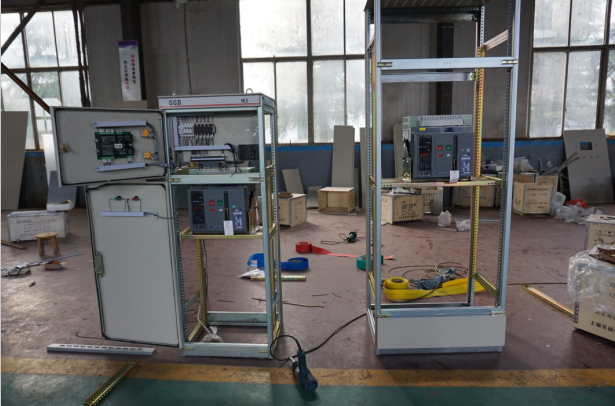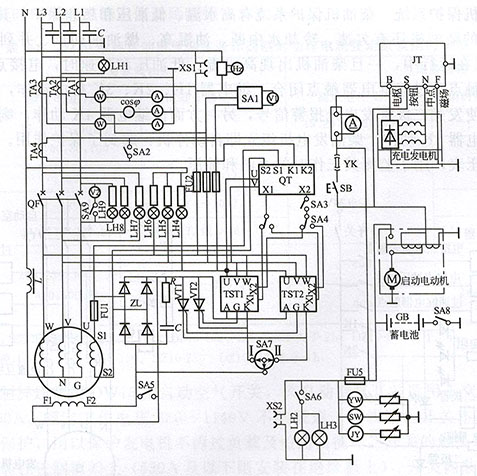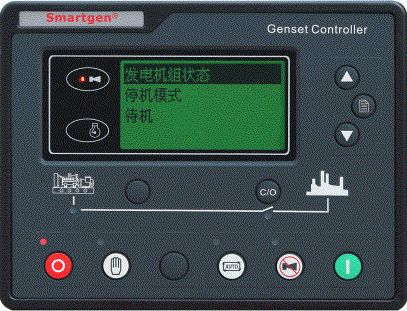The main purpose of the diesel generator control panel is to distribute the electrical energy output by the generator to the user load or the electrical equipment. It is also used to indicate the operation of the diesel generator and to maintain the voltage stability of the generator under load changes. The control panel or controller is generally equipped with a voltmeter, a frequency meter, an ammeter, a power meter, a three-phase current conversion switch, a three-phase voltage conversion switch, a voltage setting knob, and various indicator lights.

For oil pressure gauges, oil temperature gauges, battery charging ammeters, water temperature gauges, start buttons and starter locks, some are installed directly on the control panel according to the design requirements, and some are installed on the diesel dashboard. The components installed inside the control panel are mainly related to the excitation mode used by the generator and the automatic control of the diesel engine.

The structure and equipment of the control panel (box) of the diesel generator set are different, and the usage and maintenance contents are also different. The following uses the PF13-75 control box (shown below) as an example to briefly explain the use and maintenance of the control panel (box).
1. Turn on the switch YK with the key and press the start button SB to start the diesel engine.
2. Increase the speed of the diesel engine. When the speed of the diesel engine rises to near the rated value, the generator can generate electricity by itself. The generator voltage can be adjusted by the potentiometer of the excitation regulator TST1 (or TST2). When the diesel engine is running and the generator is not generating power, the degaussing switch SA5 can be turned on.
3. The three-phase voltage of the generator can be measured by the changeover switch SA1 and the voltmeter V1.
4. The insulation of the generator can be monitored by the "insulation monitoring" lamps LH4 to LH6. When a certain short circuit is short-circuited, the corresponding insulation monitor lamp does not light.
5. When the automatic air switch is turned on, the output (or closing) indicator HL1 lights up, indicating that the unit has supplied power to the load.
6. The working condition of the diesel engine is monitored by the oil temperature meter YW, the oil pressure gauge JY, the water temperature meter SW, the frequency meter Hz and the charging current meter A. The working condition of the generator is monitored by voltmeter V1, ammeter A, frequency table Hz, power meter W, and power factor table cosφ.
7. When the generator is running in a single unit, the SA3 should be placed in the “single unit” position, the synchronization meter V2 switch SA9 should be placed in the “off” position, and the excitation regulator SA7 should be placed in the desired position. When SA7 is placed in position "I", AVR1 is put into operation; when it is placed in position "II", AVR2 is put into work; placed in position "I+II", two excitation regulators control generator work in parallel, which is out of control Pressure protection ensures the reliability of the unit when it is running "single unit".
8. When the generator is running in parallel, SA3 should be placed in the "parallel" position, SA9 should be placed in the "on" position, and SA7 should be placed in the "I" or "II" position, but not in "I+II", otherwise Can not control the parallel operation.
9. The two generator sets that are running in parallel should be adjusted to the adjustable speed setting position so that the unit can adjust the rate to -3% (class III power station) or -5% (class IV power station) under rated active power. For diesel engines without adjustable speed control, the preferred diesel engine should be paired to make the adjustment rate as uniform as possible.
10. The two diesel generator sets operating in parallel shall be respectively set to the differential resistance of the reactive power regulator QT, so that the rated voltage of the diesel generator set is 3% of the rated voltage under the rated load with a rated power factor of 0.8 (Class III) Power station) or -5% (Class IV power station).
11. When the generator sets are running in parallel, they must meet the same phase sequence, consistent voltage, and consistent frequency, and operate according to the parallel operation method.
12. Load transfer after the genset is running. When one generator is operated in parallel with another (or several) generators, load transfer must be performed. The active power transfer is to adjust the throttle of the diesel engine. The larger the throttle, the more work there is. The smaller the throttle, the smaller the work. Reactive power transfer is to adjust the excitation potentiometer in the excitation regulator to adjust the excitation current of the generator. The larger the excitation current is, the greater the reactive power is. The smaller the excitation current is, the smaller the reactive power is. The load transfer is usually carried out in stages, that is, a part of the active power is transferred first, and then a part of the reactive power is transferred, so that the step-by-step transfer to the balance (that is, the equal distribution according to the rated power ratio).
13. Unit disengagement operation: When the total load is reduced, it is enough to make a unit disengage, the tuning potentiometer of the diesel engine throttle and the excitation regulator can be adjusted separately, the active power and reactive power are reduced to zero, and then the unit is unpacked.

1. The control panel (box) must be kept dry, clean, and well ventilated during use to prevent dust, water droplets, metal or other debris from entering the cabinet.
2. Regular inspection and maintenance, check whether the contact of each part is good, whether the fastening screws are loose, whether the electrical contacts are intact, whether the insulation and heating of the coil are normal, and repair in time according to existing problems.
3. If it has not been used for a long time, the insulation resistance of the relevant electrical components should be measured before use. If it is found to be damp, the wetted components should be dried before being used.
Copyright © Guangxi Dingbo Generator Set Manufacturing Co., Ltd. All Rights Reserved | Sitemap
Update cookies preferences